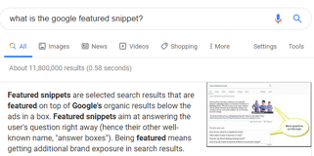
For many business owners, showing up on the first page of a search engine results page (SERP) for a keyword or search term is the ultimate achievement, and for very valid reasons. It’s estimated that fewer than 3% of organic search clicks come from search results displayed after the first page. Occupying the top rankings within any organic search result is a surefire way to bring traffic, leads and credibility to a website, and it brings further SEO value since there is a positive feedback loop from increased exposure.
What is Position Zero In Google?
Most search engine results pages display 10 results. But, on some there are technically 11 results because the first one is displayed as a paragraph of text (with a link to the URL) that the search engine algorithm has deemed highly likely to answer a query. These results are known as “featured snippets” or “rich snippets” and they act to provide reliable information and insights without requiring the searcher to click off the search results page.
Because featured snippets occupy space above the traditional 10 search results displayed on Google’s page one, many SEO/SEM experts refer to this as “Position Zero.”
Should We Aim For Featured Snippets?
Featured snippets are somewhat controversial in the SEO world. There are a lot of benefits to having your site highlighted in the featured snippet. They are popular with searchers because they allow users to get quick answers to their questions. And it does give a site some brand exposure to be in that position. According to a study conducted by Visme, a design tool and data presentation service, a little more than 12% of search queries had featured snippets in the SERP.
However, the same study revealed that SERPs with featured snippets saw an 18.5% decrease in clicks on the main organic results page. Translation: Users read the featured snippets but often do not click the link to the page where the content is coming from. As a result, having a page listed as the featured snippet can actually reduce web traffic to a page in some instances.

Should You Optimize for Featured Snippets?
If featured snippets could reduce click-throughs to a site, should you avoid optimizing for the featured snippet and instead aim for the top organic results position? It depends on your overall SEO strategy and organizational goals.
Mobile Search & Rich Snippets
Media analytics firm Comscore estimates that this year voice searches using smart speakers, Siri and other voice assistants will reach 50% of search volume across the entire Internet. Considering the popularity of Siri, Alexa and Google Assistant, this should come as no surprise. Because the majority of voice search is done in question form, the answers to those voice queries are the featured snippet answer. The voice assistant reads the featured snippet to you. And remember, there is no number two position on a voice search.
Rich Snippets Are Used Mostly InSearches That Have Little Direct Monetary Value
Additionally, it’s critical to understand that featured snippets are featured most often within informational searches, not transactional or directional searches. Answers to basic questions, “how to’s,” facts and other similar searches are where featured snippets most commonly appear. These kinds of results are no doubt valuable for growing site traffic, but they typically have little direct impact on a business’s revenue.
Searches for business services, products, and other revenue or lead-based searches typically do not have featured snippets included.
Rich Snippets Are Helpful For Increasing Site Authority
While informational search results may not be directly linked to new leads or transactions, they are critical toward growing a site’s authority. Over a long period of time, better site authority can improve overall rankings for all types of search queries, including ones that generate leads, product sales, and other searches that are highly valuable to businesses.
From this perspective, occupying “position zero” as a rich snippet may not increase clicks to a site, but it may actually generate more inbound links to the page providing the resource. In the long run, this will be net positive despite potentially lower traffic than the second search result.
What Are the 4 Steps to Featured Snippet-hood?
Want to aim high, for position zero? Here are few useful tips to land your site at the top of search results, and maybe even as the featured snippet:
- Perform keyword research to discover what content currently ranks for the featured snippet spot in your industry and optimize your website accordingly.
- Continue working on overall SEO for your website, as the majority of featured snippets are taken from page one of Google search results.
- Pay attention to the structure of your website content, as featured snippets come in different formats. Google tends to prefer answers formatted in a way that makes the most sense. For example, when searching for a recipe, the ingredients list is more often than not populated as a list, not a table. Keep in mind there are also different ways to optimize a featured snippet depending on its format.
- Type in questions related to your industry on Google and see what featured snippets appear and the questions that follow. Then make sure that your website has one solid article that can answer similar questions. This demonstrates to Google that the topic, and your website, are relevant and can be useful to many people, which helps improve ranking.

